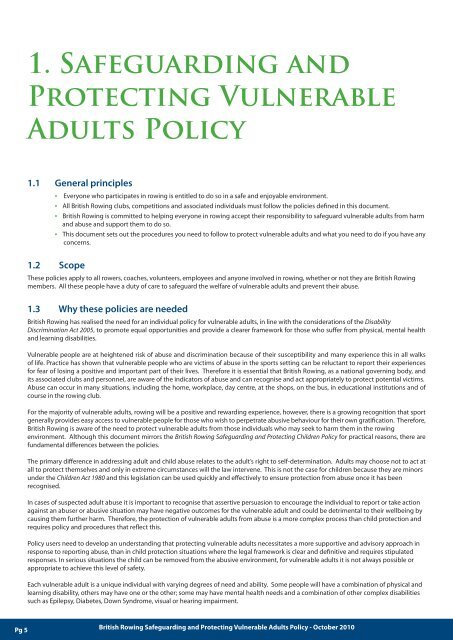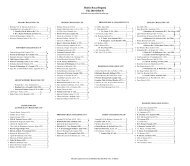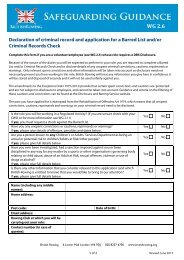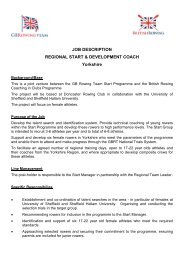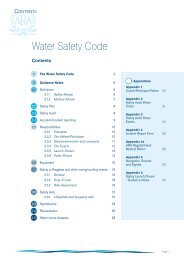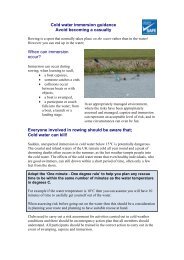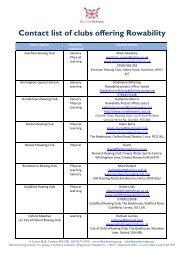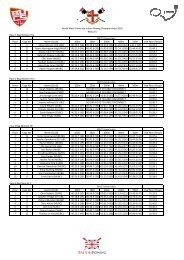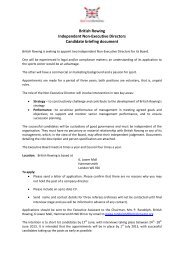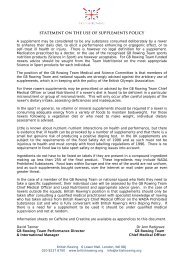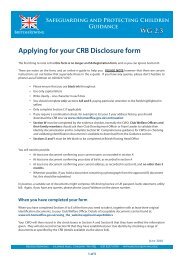British Rowing Safeguarding and Protecting Vulnerable Adults Policy
British Rowing Safeguarding and Protecting Vulnerable Adults Policy
British Rowing Safeguarding and Protecting Vulnerable Adults Policy
You also want an ePaper? Increase the reach of your titles
YUMPU automatically turns print PDFs into web optimized ePapers that Google loves.
1. <strong>Safeguarding</strong> <strong>and</strong><strong>Protecting</strong> <strong>Vulnerable</strong><strong>Adults</strong> <strong>Policy</strong>1.1 General principles• Everyone who participates in rowing is entitled to do so in a safe <strong>and</strong> enjoyable environment.• All <strong>British</strong> <strong>Rowing</strong> clubs, competitions <strong>and</strong> associated individuals must follow the policies defined in this document.• <strong>British</strong> <strong>Rowing</strong> is committed to helping everyone in rowing accept their responsibility to safeguard vulnerable adults from harm<strong>and</strong> abuse <strong>and</strong> support them to do so.• This document sets out the procedures you need to follow to protect vulnerable adults <strong>and</strong> what you need to do if you have anyconcerns.1.2 ScopeThese policies apply to all rowers, coaches, volunteers, employees <strong>and</strong> anyone involved in rowing, whether or not they are <strong>British</strong> <strong>Rowing</strong>members. All these people have a duty of care to safeguard the welfare of vulnerable adults <strong>and</strong> prevent their abuse.1.3 Why these policies are needed<strong>British</strong> <strong>Rowing</strong> has realised the need for an individual policy for vulnerable adults, in line with the considerations of the DisabilityDiscrimination Act 2005, to promote equal opportunities <strong>and</strong> provide a clearer framework for those who suffer from physical, mental health<strong>and</strong> learning disabilities.<strong>Vulnerable</strong> people are at heightened risk of abuse <strong>and</strong> discrimination because of their susceptibility <strong>and</strong> many experience this in all walksof life. Practice has shown that vulnerable people who are victims of abuse in the sports setting can be reluctant to report their experiencesfor fear of losing a positive <strong>and</strong> important part of their lives. Therefore it is essential that <strong>British</strong> <strong>Rowing</strong>, as a national governing body, <strong>and</strong>its associated clubs <strong>and</strong> personnel, are aware of the indicators of abuse <strong>and</strong> can recognise <strong>and</strong> act appropriately to protect potential victims.Abuse can occur in many situations, including the home, workplace, day centre, at the shops, on the bus, in educational institutions <strong>and</strong> ofcourse in the rowing club.For the majority of vulnerable adults, rowing will be a positive <strong>and</strong> rewarding experience, however, there is a growing recognition that sportgenerally provides easy access to vulnerable people for those who wish to perpetrate abusive behaviour for their own gratification. Therefore,<strong>British</strong> <strong>Rowing</strong> is aware of the need to protect vulnerable adults from those individuals who may seek to harm them in the rowingenvironment. Although this document mirrors the <strong>British</strong> <strong>Rowing</strong> <strong>Safeguarding</strong> <strong>and</strong> <strong>Protecting</strong> Children <strong>Policy</strong> for practical reasons, there arefundamental differences between the policies.The primary difference in addressing adult <strong>and</strong> child abuse relates to the adult’s right to self-determination. <strong>Adults</strong> may choose not to act atall to protect themselves <strong>and</strong> only in extreme circumstances will the law intervene. This is not the case for children because they are minorsunder the Children Act 1980 <strong>and</strong> this legislation can be used quickly <strong>and</strong> effectively to ensure protection from abuse once it has beenrecognised.In cases of suspected adult abuse it is important to recognise that assertive persuasion to encourage the individual to report or take actionagainst an abuser or abusive situation may have negative outcomes for the vulnerable adult <strong>and</strong> could be detrimental to their wellbeing bycausing them further harm. Therefore, the protection of vulnerable adults from abuse is a more complex process than child protection <strong>and</strong>requires policy <strong>and</strong> procedures that reflect this.<strong>Policy</strong> users need to develop an underst<strong>and</strong>ing that protecting vulnerable adults necessitates a more supportive <strong>and</strong> advisory approach inresponse to reporting abuse, than in child protection situations where the legal framework is clear <strong>and</strong> definitive <strong>and</strong> requires stipulatedresponses. In serious situations the child can be removed from the abusive environment, for vulnerable adults it is not always possible orappropriate to achieve this level of safety.Each vulnerable adult is a unique individual with varying degrees of need <strong>and</strong> ability. Some people will have a combination of physical <strong>and</strong>learning disability, others may have one or the other; some may have mental health needs <strong>and</strong> a combination of other complex disabilitiessuch as Epilepsy, Diabetes, Down Syndrome, visual or hearing impairment.Pg 5<strong>British</strong> <strong>Rowing</strong> <strong>Safeguarding</strong> <strong>and</strong> <strong>Protecting</strong> <strong>Vulnerable</strong> <strong>Adults</strong> <strong>Policy</strong> - October 2010


